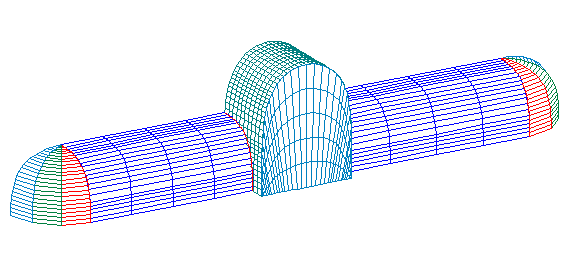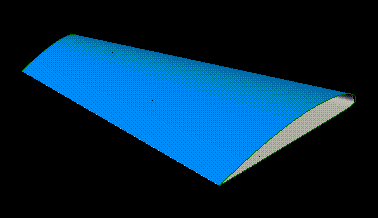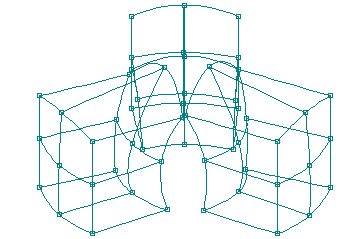Pilot3D and Rhino3D
A number of customers use our Pilot3D program for detailed NURB surface design along with McNeel's Rhino3D and Flamingo software. This combination of programs is very powerful and low cost. Although there is some overlap of NURB design functions, each program has its own strengths. Both programs use trimmed NURB surfaces so there are no geometry problems transferring data back and forth. Most of our customers use Pilot3D for detailed surface design and (Class A) shaping. There are also tools for developable surface creation and development, surface expansion, and a database of over 1500 airfoil shapes. Then, they will transfer the model to Rhino to do many of the other details, create a complex design, and to use their powerful Flamingo to produce stunning images.
Some of the ways that Pilot3D will help Rhino users are:
1. Detailed surface shaping and control. We have been developing B-spline and NURB surface software for over 20 years and many like our no-vertex, edit points on the surface direct shape control. You have both coarse and fine-tune direct surface shape control using dynamic curvature curve smoothness feedback. You can also display section cuts while you are directly controlling the shape of the surface.

Upside down hull showing the detailed shape control you have with Pilot3D.
2. Reverse Engineering. Pilot3D has a number of tools that allow you to go from points to curves and curves to surfaces. There is even a loft command that will fit multiple NURB surfaces to cross-section curves at common knuckle points on the curves.

This picture shows three surfaces that were lofted through a series of combination or poly curves at one time. The three surfaces match the cross-sections very closely and are bonded together to allow the user to edit the shape without separation.
3. Developable Surface Creation. Pilot3D is the only program that gives you dynamic ruling lines to create developable surfaces quickly and easily. Ruling lines are calculated and displayed between two NURB curves with edit points that lie on the curves. All you have to do is to edit the curve points and watch the ruling lines change orientation and color. The color tells you how much twist there is in the surface.


The top picture shows ruling lines calculated and drawn between two NURB curves. All you have to do is to move (coarse or fine-tune) any edit point and watch the ruling lines change position and color. It took less than a minute to get the spread of ruling lines in the second picture. One command will then convert these ruling lines into a NURB surface.
4. Surface Development and Expansion. Pilot3D uses a finite element type of calculation to unwrap and flatten out both single and double curved surfaces. (See this very simple surface layout example.)


The top picture shows a complicated awning structure and the bottom picture shows the unwrapped pieces. Note that Pilot3D can unwrap trimmed surfaces. The model can be created in Pilot3D or it can be imported from Rhino 3D.
Pilot3D also has the ability to subdivide surfaces to define smaller sections to unwrap flat. This might be necessary to fit the material size or cutting machine, or it might be needed to reduce a very twisted (double curvature) surface into one small enough to lay flat.

Thanks to David Lemke of Victoria, Texas
5. Precision 2D and 3D Airfoils. Pilot3D gives you a database of over 1500 airfoil shapes. It is very easy to grab one from the database, scale it, and position it in your model. One for the root. One for the tip. One command to skin a 3D NURB surface and you're done.

You can also use our dynamic curvature curve fairing tool to make sure the airfoil is as smooth as possible.
6. 2D/3D Graphic Arts. Pilot3D provides a unique way to define curves and polylines. There is no difference between the two. You can mix both curves, lines, and polylines in one entity. Imagine that each edit point includes an indicator value that says whether it is a knuckle (breakpoint or polyline) point or a smooth curve point. With one command, you can flip an edit point back and forth between a smooth point and a knuckle point. You can rough up a shape using a polyline and then flip points as necessary to create smooth sections.

This is just one "curve" in Pilot3D. You can flip any edit point back and forth between a hard or knuckle point and a smooth curvefit point.
7. 3D Solid Modeling and Shelling. Pilot 3D includes a command that will offset or shell connected polysurfaces with different thicknesses. Each surface will be automatically extended or trimmed and then bonded together to allow further editing.

This solid was created by extruding a combination curve (polylines and curves) in one step to get 7 connected (bonded) NURB surfaces. The next step (shell/offset command) offset all surfaces at one time, extending or connecting overlaps as necessary, and then bonded together. The edges can then be capped off with NURB surfaces. This creates a watertight solid that does not use any trimming curves. All edges are bonded and can be edited without separation.
8. Dynamic Constraint Relationships. Pilot3D provides optional geometry relationships that you can use as needed. One of the most common constraints is called a bonded edge between surfaces. This allows you to construct polysurfaces that can be edited without separation. Single NURB surfaces can be split into two (or recombined) by just using one command on any surface row or column. When split, the surfaces remain bonded. Other relationships include merging edit points from different entities. attaching an edit point to a curve or surface, and attaching curves to a surface. For example, you can attach a curve to a surface and then edit its shape. Pilot3D will keep the curve on the surface. You can then use this curve to construct other geometry or to trim the surface. After trimming, you can still edit and move the trim curve.

This vase was created by rotate-extruding a cross-section combination curve-polyline entity into three bonded surfaces. A curve was attached to the top surface and edited to create the wavy shape. The curve was then used to trim the top surface. It can be edited without untrimming the surface.
9. Creative Surface Architecture. Pilot3D gives you tools to do creative smooth surface architectural design. You can start with simple bonded box shapes and then add shape and smoothness as needed. With edit points on the surface and all edges bonded together, you can focus on the creative design task rather than the details of the CAD program.


These pictures show how closed and bonded edge boxes can be created and changed into partially or fully curved architecture. Note how there are no vertex points or meshes to deal with. You control the surface directly and all of the surfaces stay attached. You can add in additional surface rows and columns for more shape control without affecting the bonded edges.
View the rest of our site for full details. Pilot3D can handle all of your detailed surface shaping and smoothing needs and Rhino 3D and Flamingo can handle all of the rest. Pilot3D, Rhino 3D, and Flamingo make a very powerful and low cost combination.